Deakin University HNN108: Preventing Delirium in Acute Care Settings
VerifiedAdded on 2022/09/14
|16
|2809
|20
Report
AI Summary
This report synthesizes research on interventions for preventing and reducing delirium in acute hospital settings. The assignment, completed for Deakin University's HNN108 course, analyzes three primary research papers exploring risk factors, pathophysiology, and effective strategies. Key findings highlight the importance of non-pharmacological interventions such as hypnotherapy and patient-centered care in mitigating delirium. The report emphasizes the impact of hospital settings, including room transfers and pre-operative conditions, on delirium incidence. It also discusses the role of systematic inflammation and anticholinergic drugs. Prevention strategies, including the Hospital Elder Life Program (HELP), are examined. The synthesis concludes that managing patient behavior through non-pharmacological interventions and, in some cases, pharmacological interventions, is crucial for improving outcomes for older adults in acute care settings. The report underscores the need for further research to validate findings and refine treatment approaches.
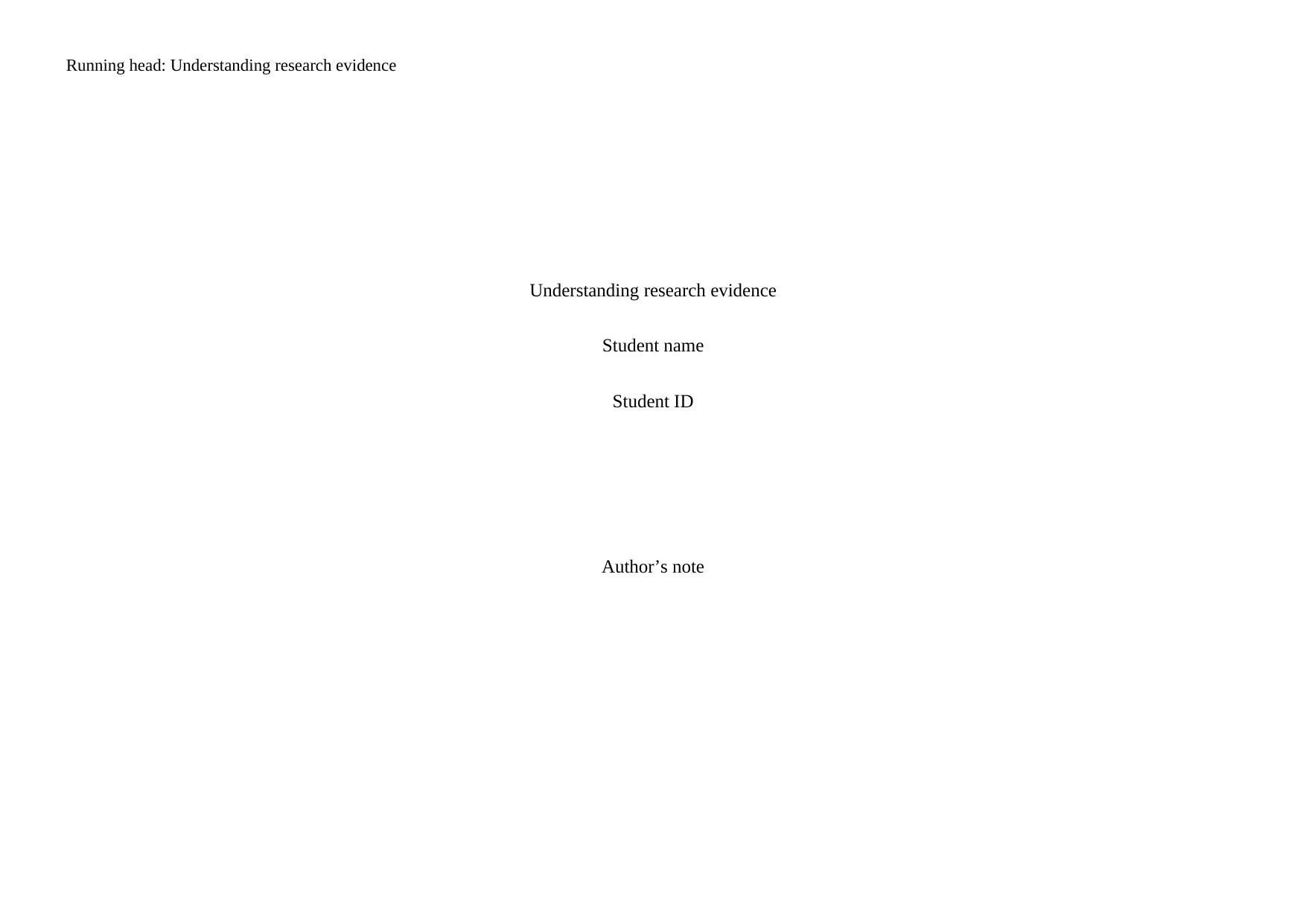
Running head: Understanding research evidence
Understanding research evidence
Student name
Student ID
Author’s note
Understanding research evidence
Student name
Student ID
Author’s note
Paraphrase This Document
Need a fresh take? Get an instant paraphrase of this document with our AI Paraphraser
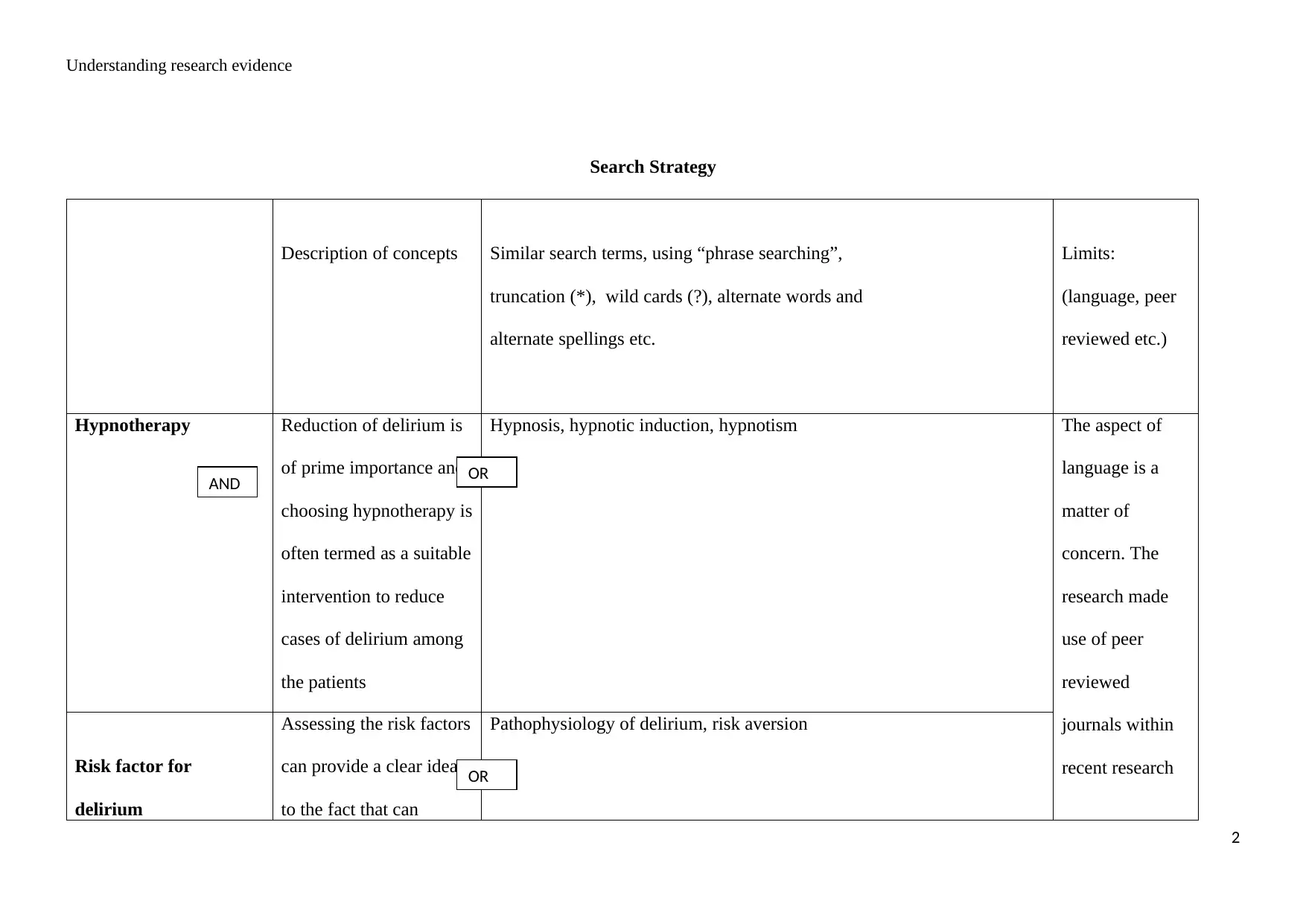
Understanding research evidence
Search Strategy
Description of concepts Similar search terms, using “phrase searching”,
truncation (*), wild cards (?), alternate words and
alternate spellings etc.
Limits:
(language, peer
reviewed etc.)
Hypnotherapy Reduction of delirium is
of prime importance and
choosing hypnotherapy is
often termed as a suitable
intervention to reduce
cases of delirium among
the patients
Hypnosis, hypnotic induction, hypnotism The aspect of
language is a
matter of
concern. The
research made
use of peer
reviewed
journals within
recent researchRisk factor for
delirium
Assessing the risk factors
can provide a clear idea
to the fact that can
Pathophysiology of delirium, risk aversion
2
AND OR
OR
Search Strategy
Description of concepts Similar search terms, using “phrase searching”,
truncation (*), wild cards (?), alternate words and
alternate spellings etc.
Limits:
(language, peer
reviewed etc.)
Hypnotherapy Reduction of delirium is
of prime importance and
choosing hypnotherapy is
often termed as a suitable
intervention to reduce
cases of delirium among
the patients
Hypnosis, hypnotic induction, hypnotism The aspect of
language is a
matter of
concern. The
research made
use of peer
reviewed
journals within
recent researchRisk factor for
delirium
Assessing the risk factors
can provide a clear idea
to the fact that can
Pathophysiology of delirium, risk aversion
2
AND OR
OR
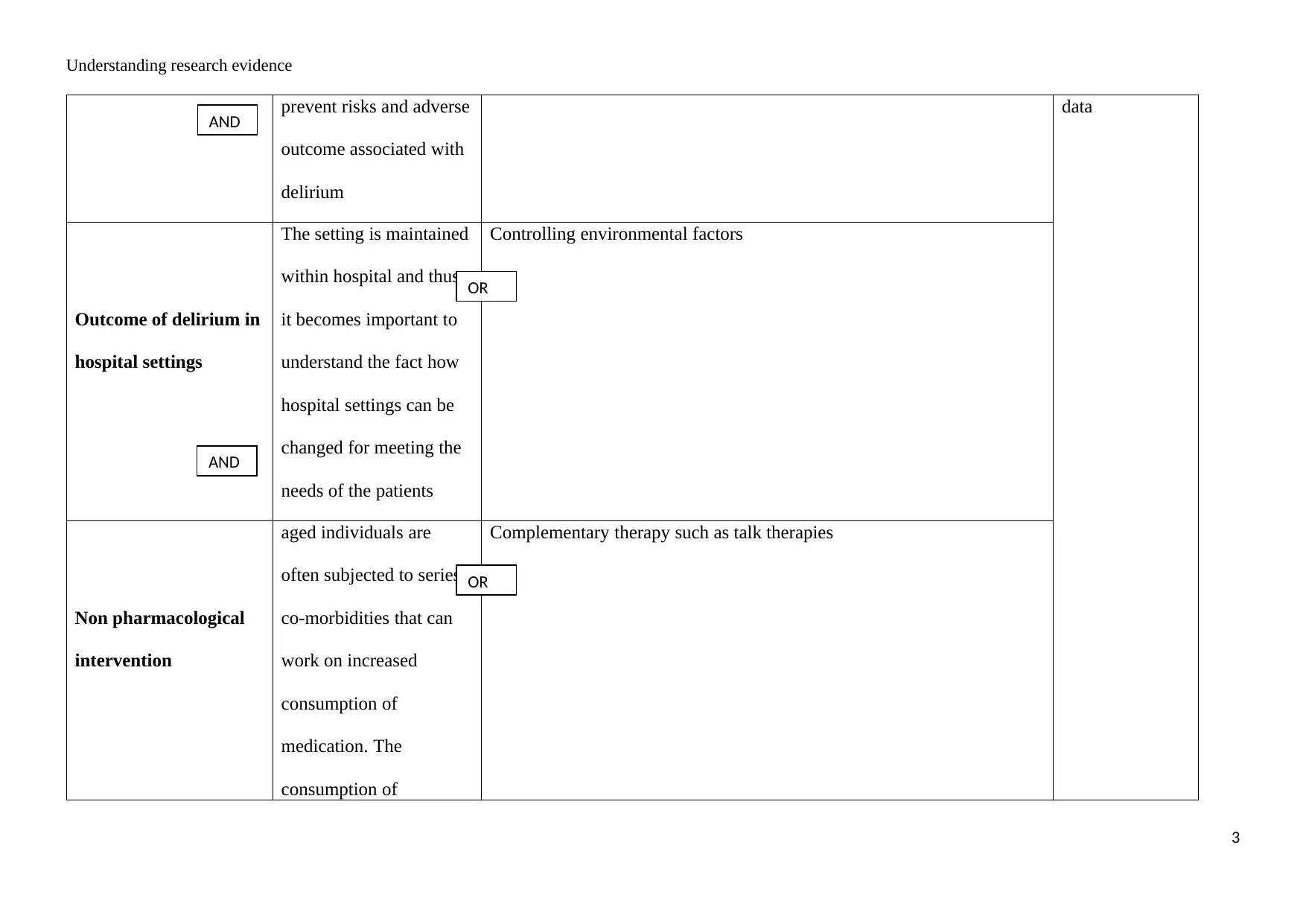
Understanding research evidence
prevent risks and adverse
outcome associated with
delirium
data
Outcome of delirium in
hospital settings
The setting is maintained
within hospital and thus,
it becomes important to
understand the fact how
hospital settings can be
changed for meeting the
needs of the patients
Controlling environmental factors
Non pharmacological
intervention
aged individuals are
often subjected to series
co-morbidities that can
work on increased
consumption of
medication. The
consumption of
Complementary therapy such as talk therapies
3
AND
AND
OR
OR
prevent risks and adverse
outcome associated with
delirium
data
Outcome of delirium in
hospital settings
The setting is maintained
within hospital and thus,
it becomes important to
understand the fact how
hospital settings can be
changed for meeting the
needs of the patients
Controlling environmental factors
Non pharmacological
intervention
aged individuals are
often subjected to series
co-morbidities that can
work on increased
consumption of
medication. The
consumption of
Complementary therapy such as talk therapies
3
AND
AND
OR
OR
⊘ This is a preview!⊘
Do you want full access?
Subscribe today to unlock all pages.

Trusted by 1+ million students worldwide
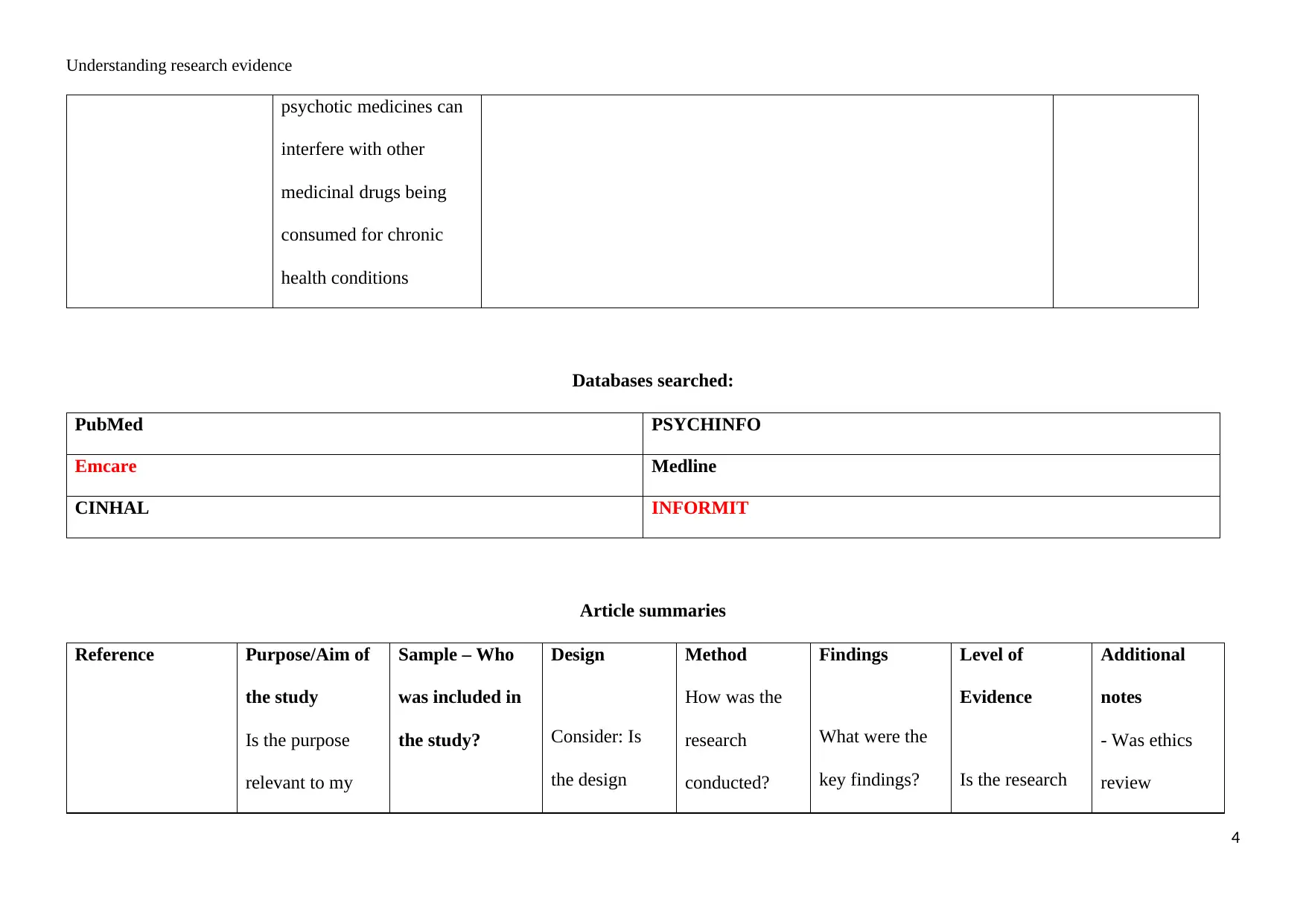
Understanding research evidence
psychotic medicines can
interfere with other
medicinal drugs being
consumed for chronic
health conditions
Databases searched:
PubMed PSYCHINFO
Emcare Medline
CINHAL INFORMIT
Article summaries
Reference Purpose/Aim of
the study
Is the purpose
relevant to my
Sample – Who
was included in
the study?
Design
Consider: Is
the design
Method
How was the
research
conducted?
Findings
What were the
key findings?
Level of
Evidence
Is the research
Additional
notes
- Was ethics
review
4
psychotic medicines can
interfere with other
medicinal drugs being
consumed for chronic
health conditions
Databases searched:
PubMed PSYCHINFO
Emcare Medline
CINHAL INFORMIT
Article summaries
Reference Purpose/Aim of
the study
Is the purpose
relevant to my
Sample – Who
was included in
the study?
Design
Consider: Is
the design
Method
How was the
research
conducted?
Findings
What were the
key findings?
Level of
Evidence
Is the research
Additional
notes
- Was ethics
review
4
Paraphrase This Document
Need a fresh take? Get an instant paraphrase of this document with our AI Paraphraser
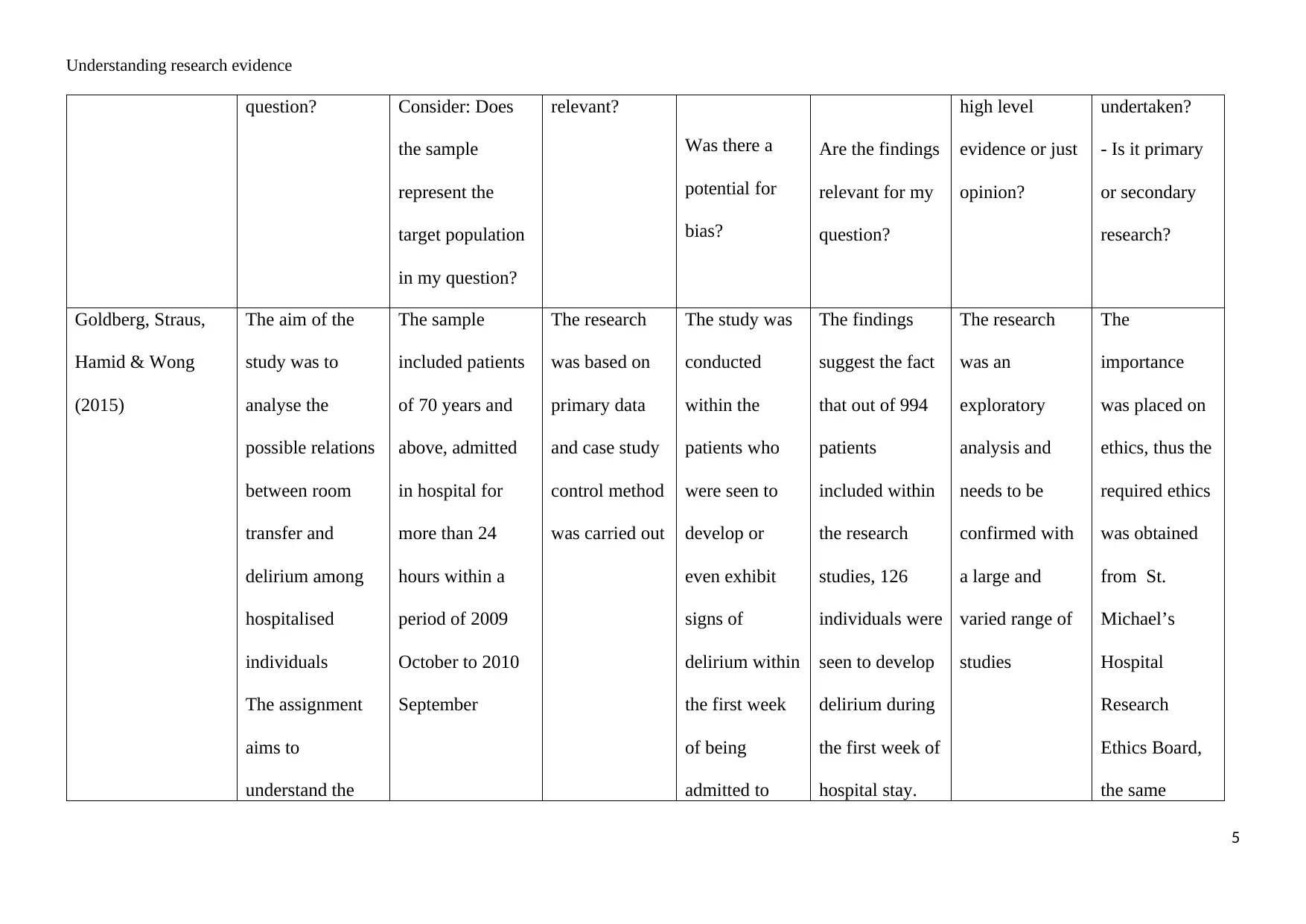
Understanding research evidence
question? Consider: Does
the sample
represent the
target population
in my question?
relevant?
Was there a
potential for
bias?
Are the findings
relevant for my
question?
high level
evidence or just
opinion?
undertaken?
- Is it primary
or secondary
research?
Goldberg, Straus,
Hamid & Wong
(2015)
The aim of the
study was to
analyse the
possible relations
between room
transfer and
delirium among
hospitalised
individuals
The assignment
aims to
understand the
The sample
included patients
of 70 years and
above, admitted
in hospital for
more than 24
hours within a
period of 2009
October to 2010
September
The research
was based on
primary data
and case study
control method
was carried out
The study was
conducted
within the
patients who
were seen to
develop or
even exhibit
signs of
delirium within
the first week
of being
admitted to
The findings
suggest the fact
that out of 994
patients
included within
the research
studies, 126
individuals were
seen to develop
delirium during
the first week of
hospital stay.
The research
was an
exploratory
analysis and
needs to be
confirmed with
a large and
varied range of
studies
The
importance
was placed on
ethics, thus the
required ethics
was obtained
from St.
Michael’s
Hospital
Research
Ethics Board,
the same
5
question? Consider: Does
the sample
represent the
target population
in my question?
relevant?
Was there a
potential for
bias?
Are the findings
relevant for my
question?
high level
evidence or just
opinion?
undertaken?
- Is it primary
or secondary
research?
Goldberg, Straus,
Hamid & Wong
(2015)
The aim of the
study was to
analyse the
possible relations
between room
transfer and
delirium among
hospitalised
individuals
The assignment
aims to
understand the
The sample
included patients
of 70 years and
above, admitted
in hospital for
more than 24
hours within a
period of 2009
October to 2010
September
The research
was based on
primary data
and case study
control method
was carried out
The study was
conducted
within the
patients who
were seen to
develop or
even exhibit
signs of
delirium within
the first week
of being
admitted to
The findings
suggest the fact
that out of 994
patients
included within
the research
studies, 126
individuals were
seen to develop
delirium during
the first week of
hospital stay.
The research
was an
exploratory
analysis and
needs to be
confirmed with
a large and
varied range of
studies
The
importance
was placed on
ethics, thus the
required ethics
was obtained
from St.
Michael’s
Hospital
Research
Ethics Board,
the same
5
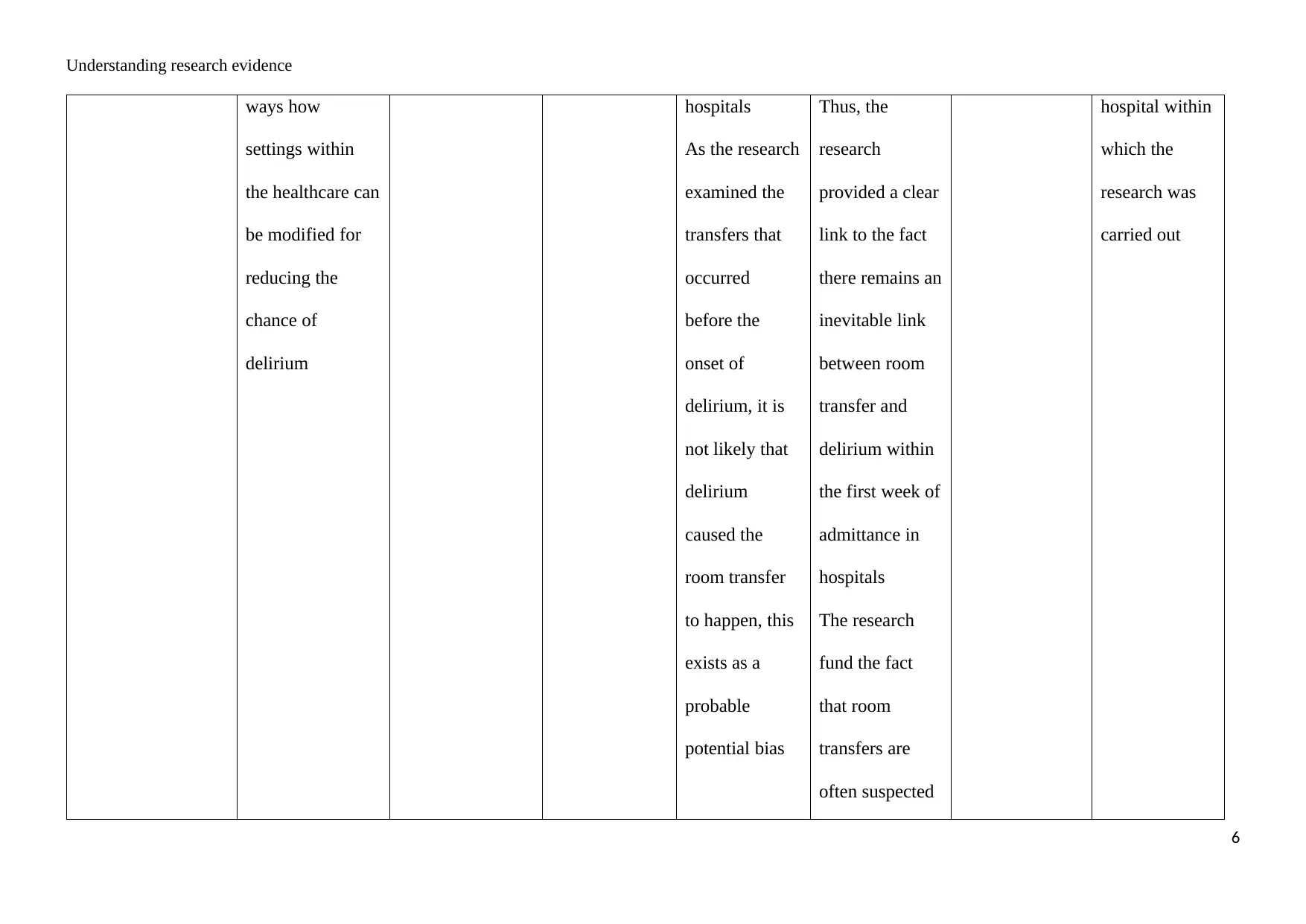
Understanding research evidence
ways how
settings within
the healthcare can
be modified for
reducing the
chance of
delirium
hospitals
As the research
examined the
transfers that
occurred
before the
onset of
delirium, it is
not likely that
delirium
caused the
room transfer
to happen, this
exists as a
probable
potential bias
Thus, the
research
provided a clear
link to the fact
there remains an
inevitable link
between room
transfer and
delirium within
the first week of
admittance in
hospitals
The research
fund the fact
that room
transfers are
often suspected
hospital within
which the
research was
carried out
6
ways how
settings within
the healthcare can
be modified for
reducing the
chance of
delirium
hospitals
As the research
examined the
transfers that
occurred
before the
onset of
delirium, it is
not likely that
delirium
caused the
room transfer
to happen, this
exists as a
probable
potential bias
Thus, the
research
provided a clear
link to the fact
there remains an
inevitable link
between room
transfer and
delirium within
the first week of
admittance in
hospitals
The research
fund the fact
that room
transfers are
often suspected
hospital within
which the
research was
carried out
6
⊘ This is a preview!⊘
Do you want full access?
Subscribe today to unlock all pages.

Trusted by 1+ million students worldwide
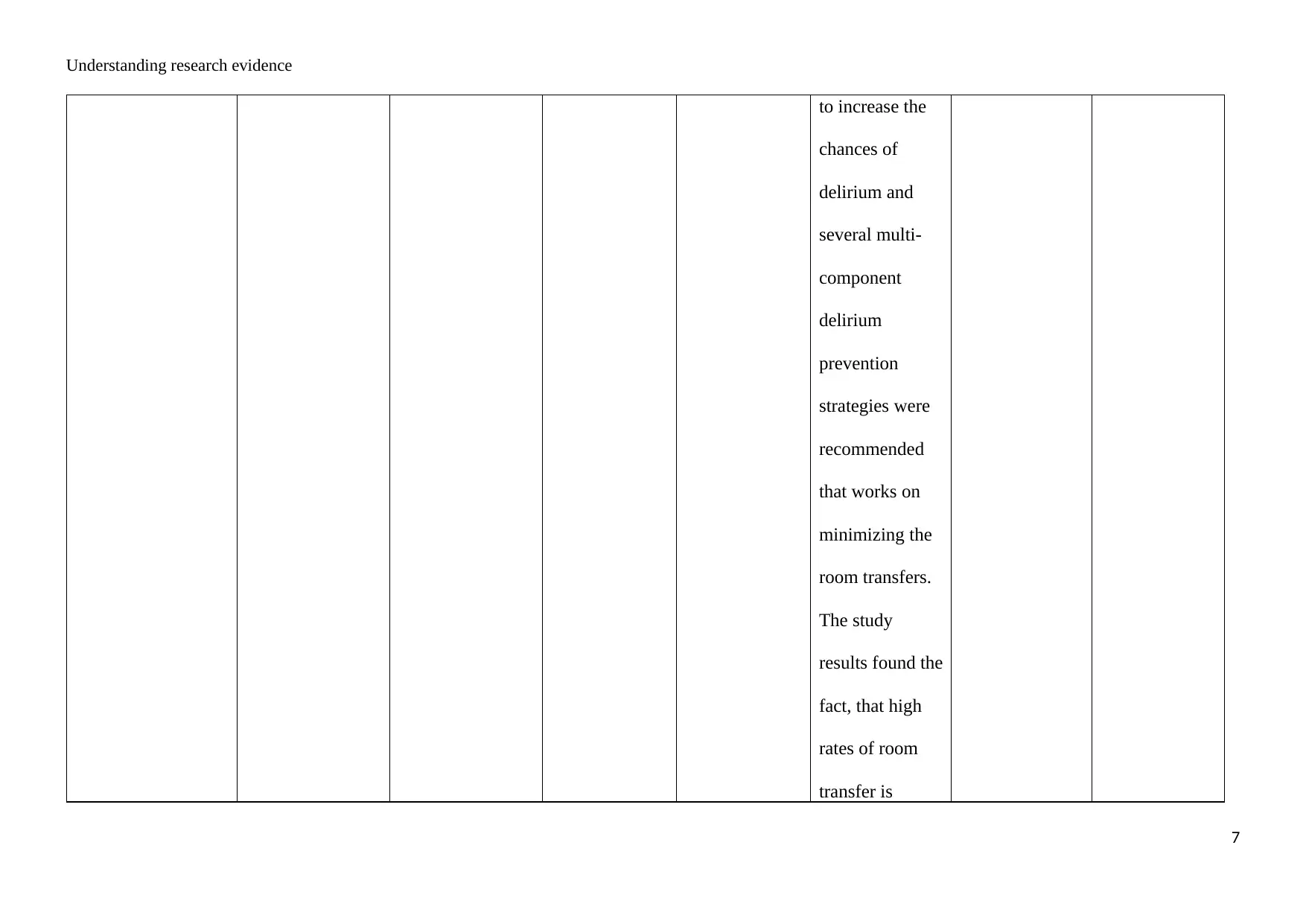
Understanding research evidence
to increase the
chances of
delirium and
several multi-
component
delirium
prevention
strategies were
recommended
that works on
minimizing the
room transfers.
The study
results found the
fact, that high
rates of room
transfer is
7
to increase the
chances of
delirium and
several multi-
component
delirium
prevention
strategies were
recommended
that works on
minimizing the
room transfers.
The study
results found the
fact, that high
rates of room
transfer is
7
Paraphrase This Document
Need a fresh take? Get an instant paraphrase of this document with our AI Paraphraser
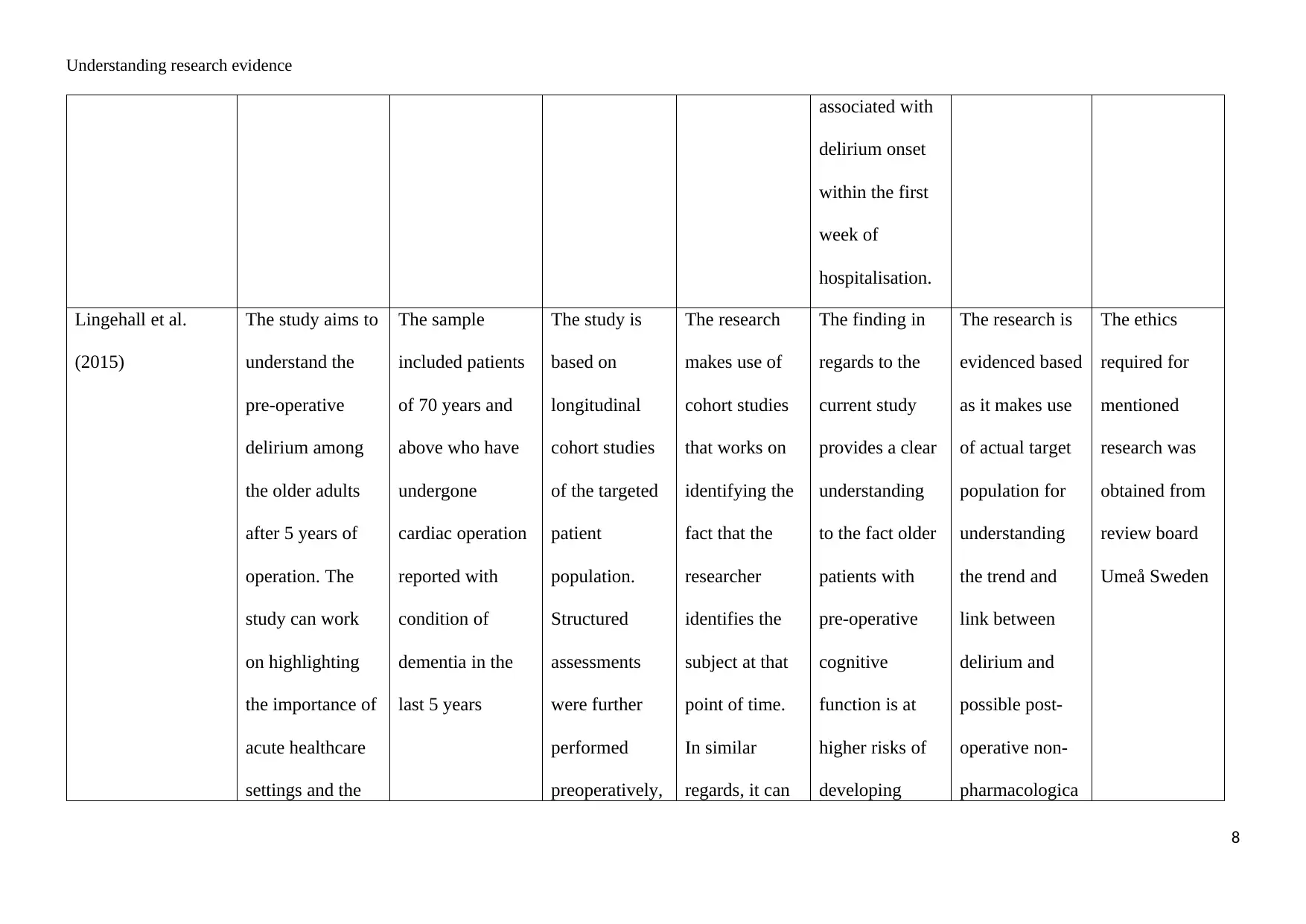
Understanding research evidence
associated with
delirium onset
within the first
week of
hospitalisation.
Lingehall et al.
(2015)
The study aims to
understand the
pre-operative
delirium among
the older adults
after 5 years of
operation. The
study can work
on highlighting
the importance of
acute healthcare
settings and the
The sample
included patients
of 70 years and
above who have
undergone
cardiac operation
reported with
condition of
dementia in the
last 5 years
The study is
based on
longitudinal
cohort studies
of the targeted
patient
population.
Structured
assessments
were further
performed
preoperatively,
The research
makes use of
cohort studies
that works on
identifying the
fact that the
researcher
identifies the
subject at that
point of time.
In similar
regards, it can
The finding in
regards to the
current study
provides a clear
understanding
to the fact older
patients with
pre-operative
cognitive
function is at
higher risks of
developing
The research is
evidenced based
as it makes use
of actual target
population for
understanding
the trend and
link between
delirium and
possible post-
operative non-
pharmacologica
The ethics
required for
mentioned
research was
obtained from
review board
Umeå Sweden
8
associated with
delirium onset
within the first
week of
hospitalisation.
Lingehall et al.
(2015)
The study aims to
understand the
pre-operative
delirium among
the older adults
after 5 years of
operation. The
study can work
on highlighting
the importance of
acute healthcare
settings and the
The sample
included patients
of 70 years and
above who have
undergone
cardiac operation
reported with
condition of
dementia in the
last 5 years
The study is
based on
longitudinal
cohort studies
of the targeted
patient
population.
Structured
assessments
were further
performed
preoperatively,
The research
makes use of
cohort studies
that works on
identifying the
fact that the
researcher
identifies the
subject at that
point of time.
In similar
regards, it can
The finding in
regards to the
current study
provides a clear
understanding
to the fact older
patients with
pre-operative
cognitive
function is at
higher risks of
developing
The research is
evidenced based
as it makes use
of actual target
population for
understanding
the trend and
link between
delirium and
possible post-
operative non-
pharmacologica
The ethics
required for
mentioned
research was
obtained from
review board
Umeå Sweden
8
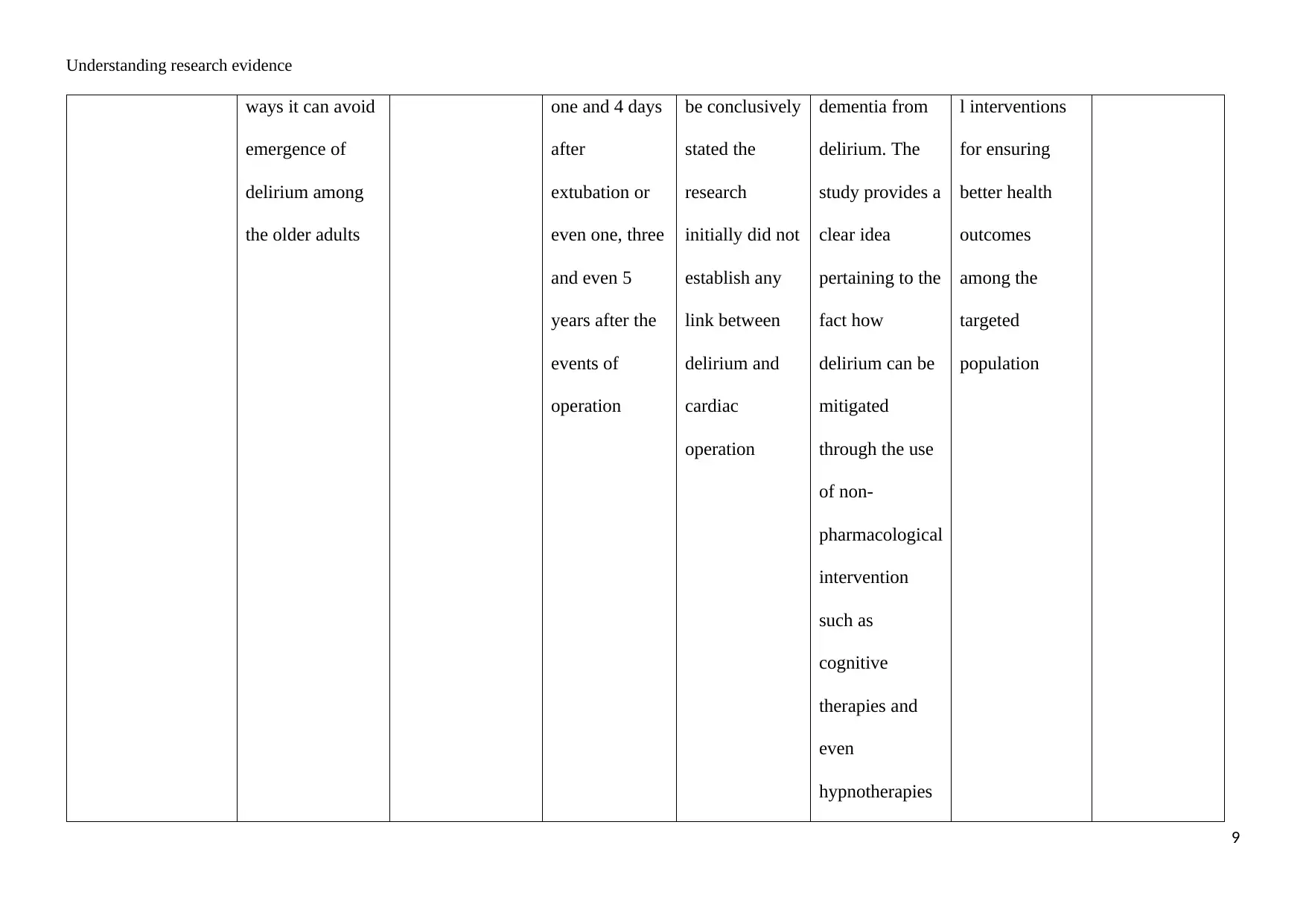
Understanding research evidence
ways it can avoid
emergence of
delirium among
the older adults
one and 4 days
after
extubation or
even one, three
and even 5
years after the
events of
operation
be conclusively
stated the
research
initially did not
establish any
link between
delirium and
cardiac
operation
dementia from
delirium. The
study provides a
clear idea
pertaining to the
fact how
delirium can be
mitigated
through the use
of non-
pharmacological
intervention
such as
cognitive
therapies and
even
hypnotherapies
l interventions
for ensuring
better health
outcomes
among the
targeted
population
9
ways it can avoid
emergence of
delirium among
the older adults
one and 4 days
after
extubation or
even one, three
and even 5
years after the
events of
operation
be conclusively
stated the
research
initially did not
establish any
link between
delirium and
cardiac
operation
dementia from
delirium. The
study provides a
clear idea
pertaining to the
fact how
delirium can be
mitigated
through the use
of non-
pharmacological
intervention
such as
cognitive
therapies and
even
hypnotherapies
l interventions
for ensuring
better health
outcomes
among the
targeted
population
9
⊘ This is a preview!⊘
Do you want full access?
Subscribe today to unlock all pages.

Trusted by 1+ million students worldwide
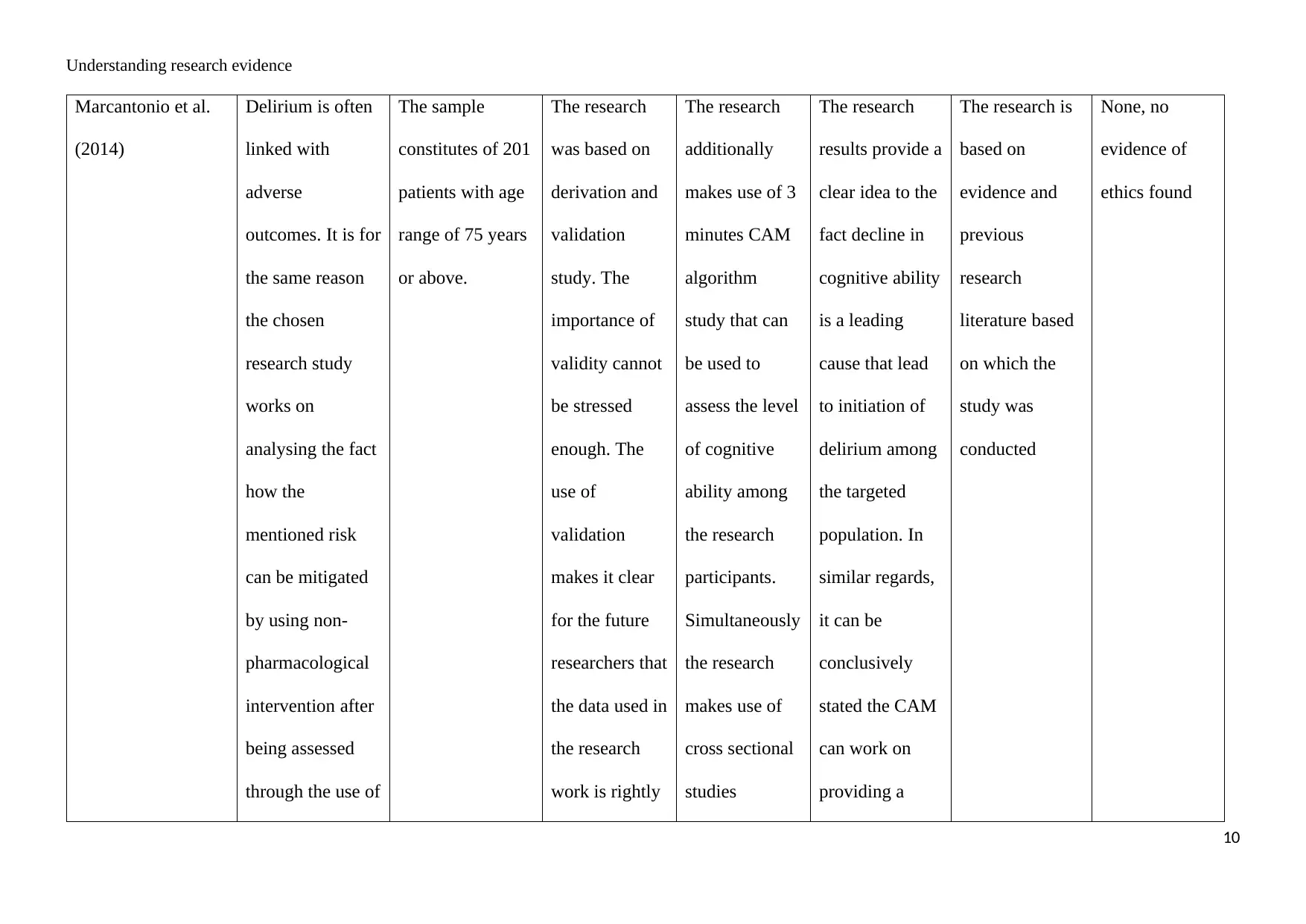
Understanding research evidence
Marcantonio et al.
(2014)
Delirium is often
linked with
adverse
outcomes. It is for
the same reason
the chosen
research study
works on
analysing the fact
how the
mentioned risk
can be mitigated
by using non-
pharmacological
intervention after
being assessed
through the use of
The sample
constitutes of 201
patients with age
range of 75 years
or above.
The research
was based on
derivation and
validation
study. The
importance of
validity cannot
be stressed
enough. The
use of
validation
makes it clear
for the future
researchers that
the data used in
the research
work is rightly
The research
additionally
makes use of 3
minutes CAM
algorithm
study that can
be used to
assess the level
of cognitive
ability among
the research
participants.
Simultaneously
the research
makes use of
cross sectional
studies
The research
results provide a
clear idea to the
fact decline in
cognitive ability
is a leading
cause that lead
to initiation of
delirium among
the targeted
population. In
similar regards,
it can be
conclusively
stated the CAM
can work on
providing a
The research is
based on
evidence and
previous
research
literature based
on which the
study was
conducted
None, no
evidence of
ethics found
10
Marcantonio et al.
(2014)
Delirium is often
linked with
adverse
outcomes. It is for
the same reason
the chosen
research study
works on
analysing the fact
how the
mentioned risk
can be mitigated
by using non-
pharmacological
intervention after
being assessed
through the use of
The sample
constitutes of 201
patients with age
range of 75 years
or above.
The research
was based on
derivation and
validation
study. The
importance of
validity cannot
be stressed
enough. The
use of
validation
makes it clear
for the future
researchers that
the data used in
the research
work is rightly
The research
additionally
makes use of 3
minutes CAM
algorithm
study that can
be used to
assess the level
of cognitive
ability among
the research
participants.
Simultaneously
the research
makes use of
cross sectional
studies
The research
results provide a
clear idea to the
fact decline in
cognitive ability
is a leading
cause that lead
to initiation of
delirium among
the targeted
population. In
similar regards,
it can be
conclusively
stated the CAM
can work on
providing a
The research is
based on
evidence and
previous
research
literature based
on which the
study was
conducted
None, no
evidence of
ethics found
10
Paraphrase This Document
Need a fresh take? Get an instant paraphrase of this document with our AI Paraphraser
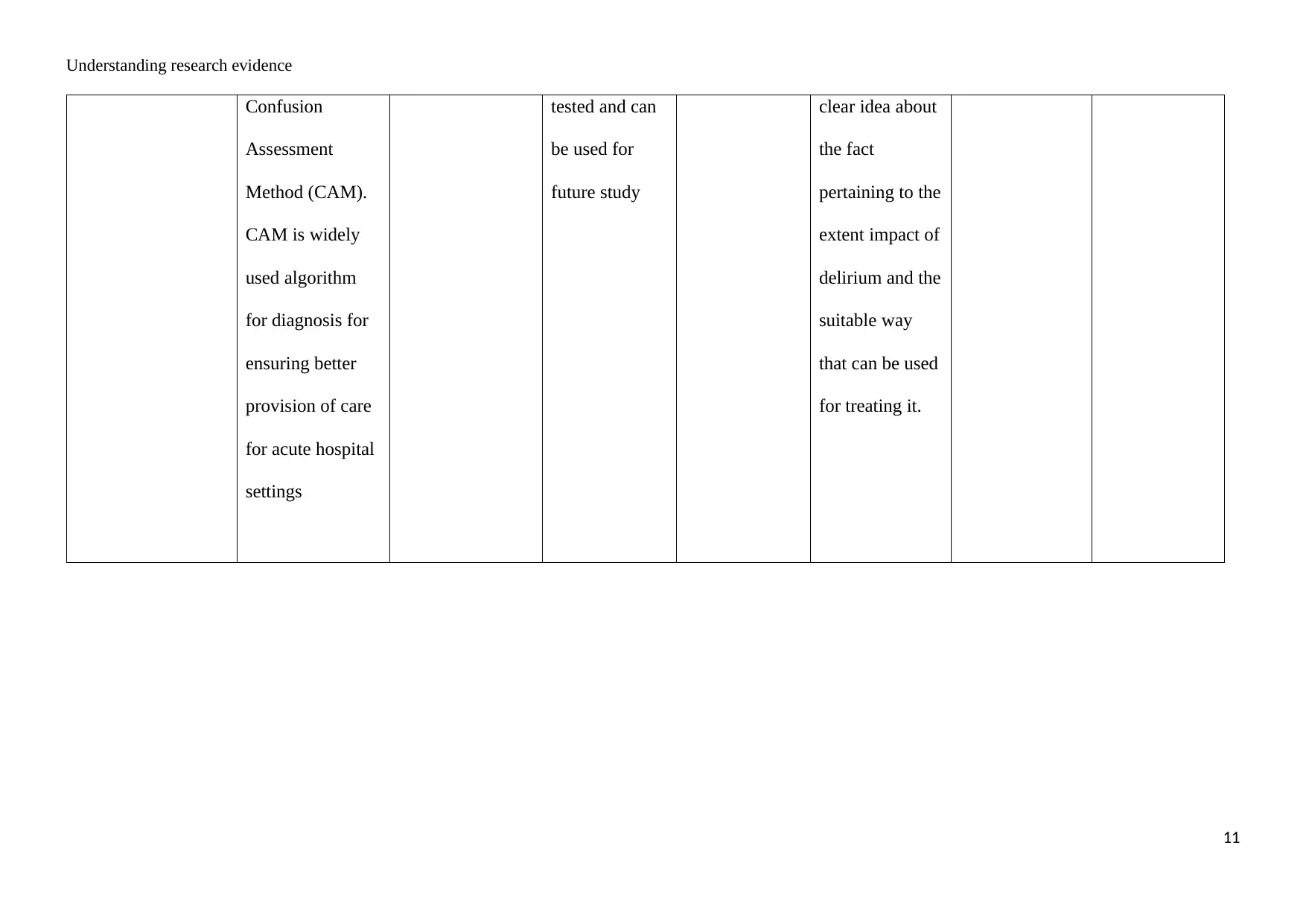
Understanding research evidence
Confusion
Assessment
Method (CAM).
CAM is widely
used algorithm
for diagnosis for
ensuring better
provision of care
for acute hospital
settings
tested and can
be used for
future study
clear idea about
the fact
pertaining to the
extent impact of
delirium and the
suitable way
that can be used
for treating it.
11
Confusion
Assessment
Method (CAM).
CAM is widely
used algorithm
for diagnosis for
ensuring better
provision of care
for acute hospital
settings
tested and can
be used for
future study
clear idea about
the fact
pertaining to the
extent impact of
delirium and the
suitable way
that can be used
for treating it.
11
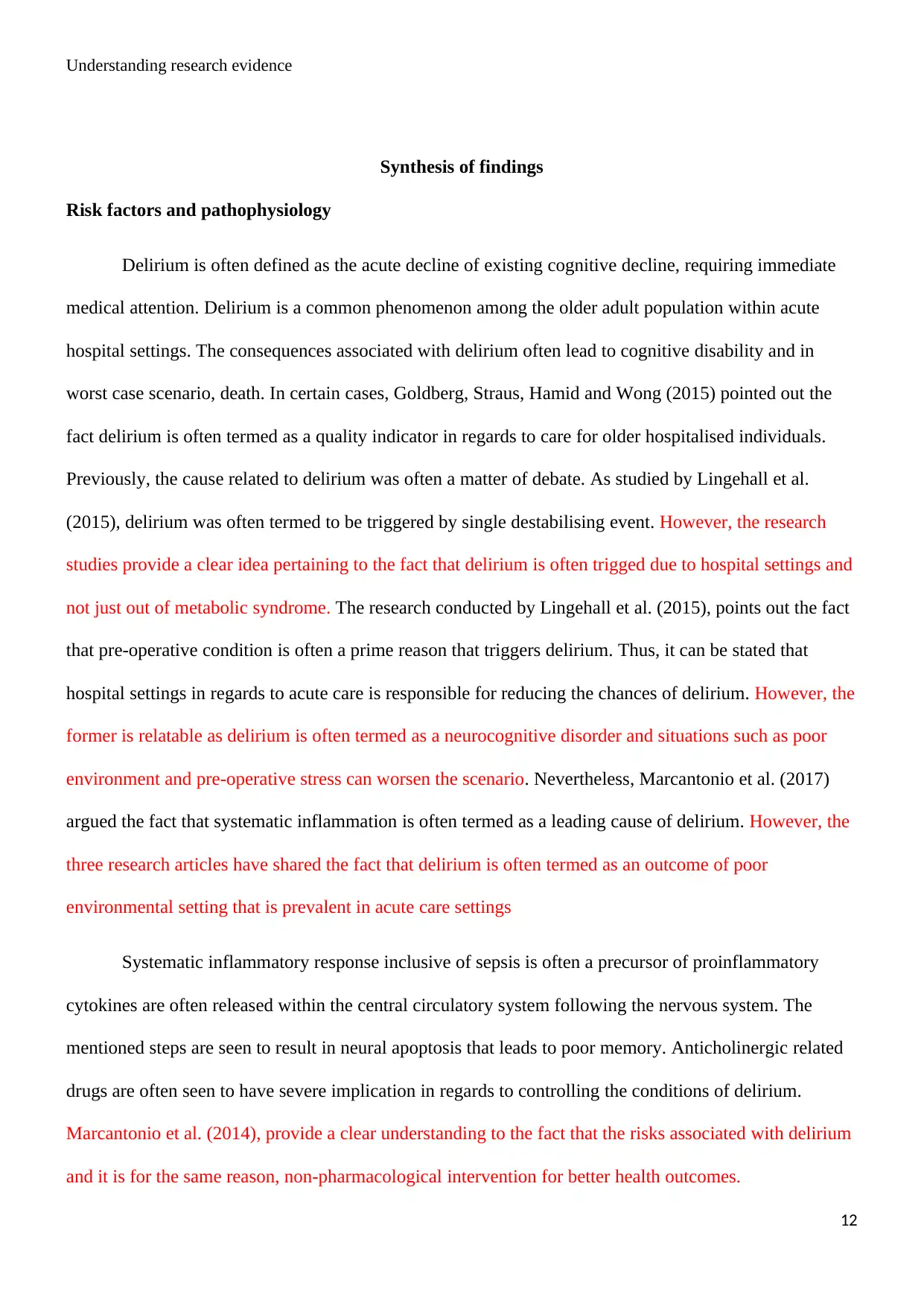
Understanding research evidence
Synthesis of findings
Risk factors and pathophysiology
Delirium is often defined as the acute decline of existing cognitive decline, requiring immediate
medical attention. Delirium is a common phenomenon among the older adult population within acute
hospital settings. The consequences associated with delirium often lead to cognitive disability and in
worst case scenario, death. In certain cases, Goldberg, Straus, Hamid and Wong (2015) pointed out the
fact delirium is often termed as a quality indicator in regards to care for older hospitalised individuals.
Previously, the cause related to delirium was often a matter of debate. As studied by Lingehall et al.
(2015), delirium was often termed to be triggered by single destabilising event. However, the research
studies provide a clear idea pertaining to the fact that delirium is often trigged due to hospital settings and
not just out of metabolic syndrome. The research conducted by Lingehall et al. (2015), points out the fact
that pre-operative condition is often a prime reason that triggers delirium. Thus, it can be stated that
hospital settings in regards to acute care is responsible for reducing the chances of delirium. However, the
former is relatable as delirium is often termed as a neurocognitive disorder and situations such as poor
environment and pre-operative stress can worsen the scenario. Nevertheless, Marcantonio et al. (2017)
argued the fact that systematic inflammation is often termed as a leading cause of delirium. However, the
three research articles have shared the fact that delirium is often termed as an outcome of poor
environmental setting that is prevalent in acute care settings
Systematic inflammatory response inclusive of sepsis is often a precursor of proinflammatory
cytokines are often released within the central circulatory system following the nervous system. The
mentioned steps are seen to result in neural apoptosis that leads to poor memory. Anticholinergic related
drugs are often seen to have severe implication in regards to controlling the conditions of delirium.
Marcantonio et al. (2014), provide a clear understanding to the fact that the risks associated with delirium
and it is for the same reason, non-pharmacological intervention for better health outcomes.
12
Synthesis of findings
Risk factors and pathophysiology
Delirium is often defined as the acute decline of existing cognitive decline, requiring immediate
medical attention. Delirium is a common phenomenon among the older adult population within acute
hospital settings. The consequences associated with delirium often lead to cognitive disability and in
worst case scenario, death. In certain cases, Goldberg, Straus, Hamid and Wong (2015) pointed out the
fact delirium is often termed as a quality indicator in regards to care for older hospitalised individuals.
Previously, the cause related to delirium was often a matter of debate. As studied by Lingehall et al.
(2015), delirium was often termed to be triggered by single destabilising event. However, the research
studies provide a clear idea pertaining to the fact that delirium is often trigged due to hospital settings and
not just out of metabolic syndrome. The research conducted by Lingehall et al. (2015), points out the fact
that pre-operative condition is often a prime reason that triggers delirium. Thus, it can be stated that
hospital settings in regards to acute care is responsible for reducing the chances of delirium. However, the
former is relatable as delirium is often termed as a neurocognitive disorder and situations such as poor
environment and pre-operative stress can worsen the scenario. Nevertheless, Marcantonio et al. (2017)
argued the fact that systematic inflammation is often termed as a leading cause of delirium. However, the
three research articles have shared the fact that delirium is often termed as an outcome of poor
environmental setting that is prevalent in acute care settings
Systematic inflammatory response inclusive of sepsis is often a precursor of proinflammatory
cytokines are often released within the central circulatory system following the nervous system. The
mentioned steps are seen to result in neural apoptosis that leads to poor memory. Anticholinergic related
drugs are often seen to have severe implication in regards to controlling the conditions of delirium.
Marcantonio et al. (2014), provide a clear understanding to the fact that the risks associated with delirium
and it is for the same reason, non-pharmacological intervention for better health outcomes.
12
⊘ This is a preview!⊘
Do you want full access?
Subscribe today to unlock all pages.

Trusted by 1+ million students worldwide
1 out of 16
Related Documents
Your All-in-One AI-Powered Toolkit for Academic Success.
+13062052269
info@desklib.com
Available 24*7 on WhatsApp / Email
![[object Object]](/_next/static/media/star-bottom.7253800d.svg)
Unlock your academic potential
Copyright © 2020–2025 A2Z Services. All Rights Reserved. Developed and managed by ZUCOL.





